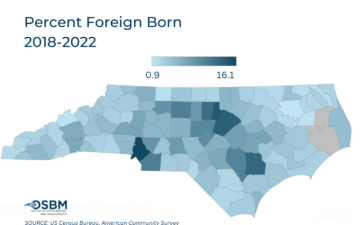North Carolina: Census 2020 Real-Time Response Rates – Week ending July 6 (.pdf)
View All County-Level Response Rates –
Week ending July 6
Key takeaways for biweekly period ending 7/5
- The growth in self-response rate now very small. As of July 5th, 58.1% of households in NC have responded to the Census, up less than half a percentage point over the past two weeks. The nation had similar growth of 0.3 percentage points, from 61.6% to 61.9%.
- North Carolina now ranks 34 out of 50 states and DC. It maintains its ranking from the previous two-week period. Its highest ranking to-date was 33rd.
- Over half of households have responded in 68 NC counties. This leaves 32 remaining counties that have yet to meet the 50% self-response benchmark. The majority of these are located in rural western and northeastern North Carolina.
- Census tracts with the most and fewest young children continue to lag the state. An average of 56% of households responded in tracts with the fewest young children – 2.1 percentage points below the state. Similarly, an average of 56.5% of households responded in tracts with the highest amount of young children – 1.6 percentage points below the state. Tracts between these two categories, on the other hand, had average response rates above the NC average.
- Tracts with fewest foreign-born residents continue to lag behind the state. As of July 5th, households in tracts with the fewest foreign-born residents had an average response rate of 54.3% – 3.8 percentage points below the state.
- Tracts with >50% minority residents lag behind NC. An average of 51.4% of households responded in tracts where the majority of residents are American Indian, Asian, Black or Hispanic/Latinx – 6.7 percentage points below the state.
- Over two-thirds of households have responded in high internet access areas compared to half in low internet access areas. An average of 50.1% of households have responded in low internet access areas – 16.4 percentage points below the average for high-access areas (66.5%).
- Five primarily urban counties outrank the state. These are Craven (61%), Forsyth (61%), Guilford (64%), Mecklenburg (61%), and Wake (67%). Each county’s response rate grew less than one percentage point from the last report.
Last updated: 7.8.20


